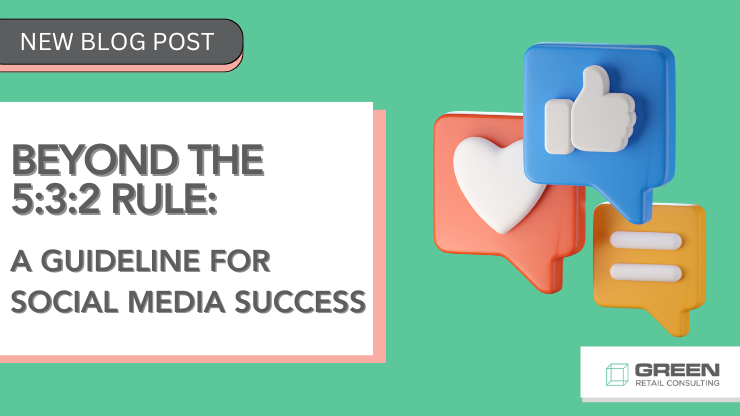In today's highly competitive digital landscape, brands must capture attention without overwhelming their audience. Striking the right balance between relevance and engagement is essential for building meaningful connections and fostering brand loyalty. Effective content creation plays a crucial role in this strategy, enabling businesses to deliver value-driven messaging that resonates with their audience—without coming across as overly promotional. By prioritizing authenticity and audience-centric storytelling, brands can cultivate trust, encourage interaction, and ultimately drive long-term success.
The 5:3:2 rule could be the strategic shift your content approach needs to drive greater engagement and impact. This strategic approach balances promotional, curated, and personal content, ensuring consistent audience engagement without becoming repetitive or overly self-promotional. By focusing on a mix of industry insights, original thought leadership, and behind-the-scenes moments, the 5:3:2 rule helps you foster a deeper connection with your followers. But, like all strategies, it’s not one-size-fits-all—different industries and audiences require tweaks to perfect the balance. Let’s break it down and explore how this rule could work for your brand.

“Content has to feel natural. People don't engage with ads, they engage with stories. Every campaign starts with understanding how real people talk about products. No hard-selling, no corporate tone. Just real conversations. A fitness brand campaign worked because the videos weren't about "features." They showed busy parents squeezing in workouts. Relatable content wins.”
UGC manager/Marketing manager, Rathly
The 5:3:2 Rule in Social Media Content
The 5:3:2 rule is a social media content strategy designed to maintain balance and engagement while avoiding excessive self-promotion. It states that for every 10 pieces of content shared:
- 5 should be curated content - valuable third-party content relevant to your audience
- 3 should be original content - your company’s insights, blog posts, case studies, or product updates
- 2 should be personal or humanizing content - content that builds relationships, such as behind-the-scenes, team culture, or fun/entertaining posts
Why Is the 5:3:2 Rule Effective?
This rule helps companies avoid being overly promotional, which can turn off audiences. By incorporating a mix of curated, original, and personal content, brands can:
- Build credibility by sharing valuable industry insights from trusted sources.
- Showcase expertise through original thought leadership.
- Increase engagement by humanizing the brand with relatable content.
- Foster relationships rather than just pushing sales messages.
We know that creating a social media calendar and marketing plan can be a daunting task. At Green Retail Consulting, we help businesses deliver an omnichannel experience for customers including digital marketing and social media plans. Here are some content ideas for each category of the 5:3:2 rule to think about moving forward when planning your social media:
5 Curated Content Ideas
🟢 Reports and whitepapers from respected sources
🟢 Relevant influencer posts
🟢 Expert opinions and case studies
🟢 Trends or best practices from reputable publications
3 Original Content Ideas
🟢Blog posts or thought leadership articles
🟢Product launches, updates, or feature highlights
🟢Customer success stories or case studies
2 Personal Humanizing Content Ideas
🟢Behind-the-scenes content (office culture, team events, workspace)
🟢Employee spotlights or fun company moments
🟢Memes, humor, or engaging polls/questions
Exceptions to the 5:3:2 Rule
Instead of rigidly adhering to the 5:3:2 rule, businesses should use it as a flexible framework, adapting their content strategy based on audience behavior, industry trends, and engagement metrics. The key is to maintain a balance that prevents over-promotion while still positioning the brand as a valuable, trustworthy resource. Content should always align with business goals and audience preferences—not a fixed formula.
For B2B companies, a heavier emphasis on curated industry insights (6:3:1 ratio) might be more valuable, as decision-makers seek authoritative, research-backed content.

“At Manifest, our content marketing strategy is built around providing real value to agency leaders who need help with new business. We follow a framework that combines thought leadership, data-driven insights and practical advice to ensure our content is both engaging and useful.
A key part of our approach is listening to our audience, analyzing common challenges, client conversations and industry trends to create content that directly addresses their needs. We focus on high-value formats such as insight reports, opinion pieces and actionable guides, which not only build trust but also position us as specialists in agency growth.
Distribution is just as important as creation, so we ensure our content reaches the right people through LinkedIn, email marketing and targeted outreach. It's not about volume but impact; quality, relevance and timing drive real engagement.”
In contrast, e-commerce brands may need a stronger focus on original content, such as product showcases and user-generated content, while relying less on curated third-party content.
Similarly, personal brands and startups often thrive by increasing personal, storytelling-driven content, making a 4:3:3 approach more effective. In time-sensitive scenarios like product launches or promotional campaigns, an even greater shift toward original content is necessary.

“In our business, we focus on creating personalized, targeted communication with our customers. By leveraging a combination of automated messaging and tailored content, we ensure that our messaging resonates with the right audience at the right time. This approach helps build deeper connections with customers, encourages repeat engagement, and drives brand loyalty. Additionally, we continually analyze customer interactions to refine our strategy, ensuring that we stay relevant and responsive to their needs. This method supports both engagement and sustainable brand growth.”
Partnerships Director, textLIVING
While this rule is a great guideline, exceptions exist based on industry, audience, and platform:
- E-commerce brands may lean more on original content showcasing products and customer experiences.
- B2B companies might focus on more curated industry insights.
- Startups & personal brands may benefit from increasing personal content (e.g., 4:3:3 instead).
- Time-sensitive campaigns (e.g., product launches) may require more promotional content temporarily.
The 5:3:2 rule keeps content engaging, varied, and audience-focused. While it’s flexible, following it ensures your social media presence remains valuable and not overly self-promotional.
We specialize in boosting growth and profitability with web design, digital marketing, merchandising strategies and supply chain optimization. We help businesses succeed in the competitive retail industry. Our innovative, data-driven approach ensures improved sales, streamlined operations and enhanced customer experiences.
For more information on how we can effectively improve your social media and digital marketing, contact us today.
Other Social Media Guidelines that you can follow:
Drive Engagement with Pillar-Cluster Model
“Our content strategy revolves around driving meaningful engagement because traffic alone doesn't guarantee results. We focus on the entire content lifecycle to ensure that users stay, interact, and ultimately convert.
How We Structure Content: We leverage the pillar-cluster model to create a content ecosystem. Pillar pages act as hubs for related subtopics, guiding users naturally from one relevant piece of content to another and keeping them engaged.
How We Keep Users Engaged: Engagement is the core of our strategy. We optimize high-performing content and repurpose it across formats, ensuring it stays relevant. By crafting compelling stories and providing actionable insights, we encourage users to stay longer, explore more, and take action-ultimately converting visitors into loyal customers.
How We Distribute Content: While engagement is our priority, content distribution follows to ensure we reach the right audience. Through SEO, partnerships, and reintroducing content over time, we keep the conversation going and maintain interest.
The goal is not just traffic-it's to create content that builds trust, inspires action, and drives long-term brand growth.”
- Gursharan Singh, Co-Founder, WebSpero Solutions
“I take a pillar-cluster approach to content marketing, ensuring every piece ladders up to a broader topic we want to own. We start by identifying high-intent search queries and then build deep, interconnected content—long-form guides, case studies, and supporting blog posts. This keeps us SEO strong while delivering real value.
I also follow the 70-20-10 rule: 70% evergreen content, 20% trend-driven insights, and 10% experimental formats like interactive tools or video series. Engagement is a priority, so we repurpose top-performing content into social snippets, email series, and even sales enablement assets. We track everything obsessively, using first-party data over vanity metrics to refine what works.
At the core, my strategy isn't about chasing clicks—it's about building authority and trust over time.”
- Nikita Sherbina, Co-Founder & CEO, AIScreenBuild Authority with Signature Content Ecosystem
“Our content marketing strategy is built on luxury positioning, value-driven storytelling, and strategic visibility. Instead of chasing short-term trends, we create timeless, high-impact content that speaks directly to our audience's aspirations and challenges.
One framework we follow is The Signature Content Ecosystem, where every piece of content serves a specific role in brand growth and engagement:
Authority Content - Long-form, high-value content (articles, media features, in-depth social posts) that positions us as industry leaders.
Conversion Content - Strategic email sequences, sales pages, and testimonials designed to drive purchases and build trust.
Community Engagement - Interactive social media content, personal storytelling, and audience-driven conversations that deepen brand loyalty.
Amplification - PR, collaborations, and cross-promotions that extend our reach to new audiences.
Repurposing and layering content across multiple platforms while maintaining a luxurious yet accessible brand voice, we maximize visibility without overwhelming our audience. This method ensures that every touchpoint—a social post, a media mention, or an email—feels intentional, high-value, and aligned with our brand's positioning.”
- Kristin Marquet, Founder & Creative Director, Marquet MediaAlign Content with Buyer Journey
“Most people will tell you to start with content pillars and build from there, and while that's not wrong, it's also not enough. A list of topics isn't a strategy, it's just a list. The real key to content marketing is making sure every piece serves a purpose in the bigger picture, which means it has to align with the actual buyer journey.
People don't engage with content just because it exists. They engage when it speaks to where they are in their decision-making process. Some people are just realizing they have a problem, some are actively looking for a solution, and some are ready to buy today. If you treat them all the same, you'll either push too hard and turn people off or be so vague that no one moves forward.
So, the way we structure content is based on three stages:
Top of Funnel (Awareness & Attention):
This is about reaching people who don't even know they need us yet. They're just starting to feel the frustration of their problem, but they might not even have the words for it yet. At this stage, our content focuses on education, storytelling, and breaking common misconceptions. Things like short-form videos, social posts, and blogs that introduce ideas in a way that makes people stop and think, "Wait, this applies to me."
Middle of Funnel (Trust & Consideration):
Now they know they need help, but they're not sure what the right solution is. This is where we focus on proof—case studies, testimonials, and deeper-dive content that builds confidence in our approach. We're not just giving value here; we're showing why our strategy works without shoving a hard sell in their face.
Bottom of Funnel (Decision & Action):
This is where the final hesitation happens, where someone is 90% there but needs that last nudge. So, our content at this stage is direct: sales pages, detailed breakdowns of our process, and strong calls to action that make taking the next step obvious.
The key to making this work is making sure every single piece of content leads somewhere. It doesn't matter how engaging a post is if it leaves people thinking, Okay, now what? That's where a lot of content marketing falls apart, businesses put out great content, but there's no clear journey attached to it.
We don't just "create content." We create momentum—ensuring that no matter when someone finds us, they always know the next step to take. A content strategy without a buyer journey isn't a strategy at all.”
- Michelle Merz, Marketing Consultant, Silience and Sonder

Leave a Comment